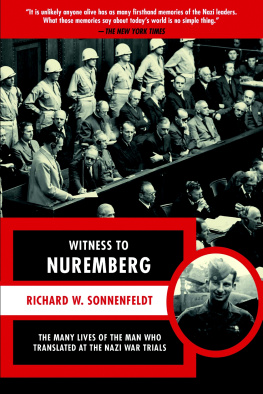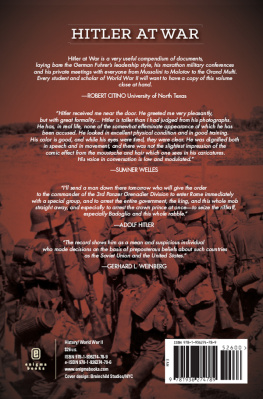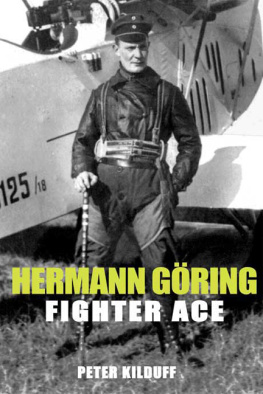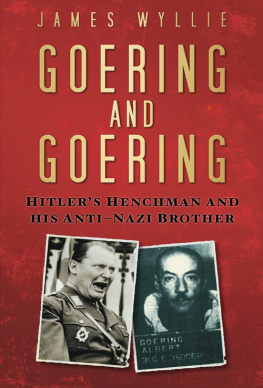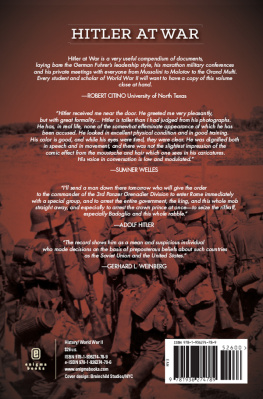THE
NAZI AND THE
PSYCHIATRIST

Copyright 2013 by Jack El-Hai.
Published in the United States by PublicAffairs, a Member of the Perseus Books Group
All rights reserved.
No part of this book may be reproduced in any manner whatsoever without written permission except in the case of brief quotations embodied in critical articles and reviews. For information, address PublicAffairs, 250 West 57th Street, 15th Floor, New York, NY 10107.
PublicAffairs books are available at special discounts for bulk purchases in the U.S. by corporations, institutions, and other organizations. For more information, please contact the Special Markets Department at the Perseus Books Group, 2300 Chestnut Street, Suite 200, Philadelphia, PA 19103, call (800) 810-4145, ext. 5000, or e-mail .
Book Design by Timm Bryson
Library of Congress Cataloging-in-Publication Data
El-Hai, Jack.
The Nazi and the psychiatrist : Hermann Gring, Dr. Douglas M. Kelley, and a fatal meeting of minds at the end of WWII / Jack El-Hai.First Edition.
pages cm
Includes bibliographical references and index.
ISBN 978-1-61039-157-3 (e-book)
1. Gring, Hermann, 18931946Psychology. 2. Kelley, Douglas M. (Douglas McGlashan), 19121958. 3. NazisPsychology. 4. War criminalsGermanyPsychology. 5. Nuremberg Trial of Major German War Criminals, Nuremberg, Germany, 19451946. 6. Nuremberg War Crime Trials, Nuremberg, Germany, 19461949. 7. NazisGermanyBiography. 8. PsychiatristsUnited StatesBiography. I. Title.
DD247.G67E4 2014
341.6'90268dc23
2013010730
First Edition
10 9 8 7 6 5 4 3 2 1
TO ESTELLE EL-HAI AND DR. ARNOLD E. ARONSON
with my love and gratitude
CONTENTS
NUREMBERG JAIL STAFF
Col. Burton Andrus, commandant
Capt. John Dolibois, welfare officer
Lt. Gustave Gilbert, psychologist
Maj. Douglas McGlashan Kelley, psychiatrist
Howard Triest, translator
NUREMBERG DEFENDANTS
Karl Dnitz, admiral and Hitlers designated successor
Hans Frank, governor-general of Nazi-occupied Poland
Wilhelm Frick, head of the radio division, German Propaganda Ministry
Walther Funk, minister of economics
Hermann Gring, Reichsmarschall and Luftwaffe chief
Rudolf Hess, deputy to the Fhrer
Alfred Jodl, chief of operations for the German High Command
Ernst Kaltenbrunner, chief of security police
Wilhelm Keitel, chief of staff of the German High Command
Robert Ley, head of the German Labor Front
Konstantin von Neurath, minister of foreign affairs (until 1938)
Franz von Papen, German vice chancellor
Erich Raeder, commander in chief of the German navy
Joachim von Ribbentrop, foreign minister
Alfred Rosenberg, Nazi party philosopher and Reichsminister for the Eastern Occupied Territories
Fritz Sauckel, chief of slave labor recruitment
Hjalmar Schacht, Reichsbank president and minister of economics (until 1937)
Baldur von Schirach, Hitler Youth leader
Arthur Seyss-Inquart, Austrian chancellor and Reich commissioner for the Netherlands
Albert Speer, Reichsminister for armaments and munitions
Julius Streicher, editor of Der Strmer
INTERNATIONAL MILITARY TRIBUNAL OFFICIALS
William Wild Bill Donovan, special assistant to the chief prosecutor
Robert Jackson, US chief of counsel for the prosecution
Judge Geoffrey Lawrence, president of the court
FAMILY OF DOUGLAS MCGLASHAN KELLEY
Charles McGlashan, grandfather
June McGlashan Kelley, mother
George Doc Kelley, father
Alice Vivienne Dukie Hill Kelley, wife
Doug, Alicia, and Allen Kelley, children
T he Kelleys lived in a sprawling, Mediterranean-style villa on Highgate Road in the hills of Kensington, north of Berkeley, California. Its red-tiled roof rose high above the distant, drifting waters of the bay, but closer, beyond the yards four terraces and stone walks and down a slope of redwood and fruit trees, stood the headstones of Sunset View Cemetery.
A little merry-go-round and a childrens swimming pool sat in the center courtyard of the Kelleys U-shaped house. The front door opened onto a hallway with the kitchen to the left, where the doctor made the familys meals using a large oven, a fast-food griddle, and a meat grinder. The kitchen connected to a pantry with a freezer. The oldest son once sat atop the humming appliance and contemplated killing his father with an ax.
The entry hallway led to a bathroom on the rightthe site of a gruesome scene that played out on the first day of 1958and beyond that to the living room, which contained a fireplace, a long sofa, and the doctors own green leather chair. The room was carpeted, with the furniture pushed against the walls to open space for guests. Sometimes Dr. Kelley would play a game there with his oldest son. The boy had to leave the room, and in his absence the doctor would move a pencil on the coffee table. When the boy returned, he had to figure out what had changed.
Beyond the living room was Dr. Kelley and Dukies bedroom, overlooking the rear of the half-acre lot. In a small closet that the children sneaked into through a hallway, they could overhear their parents fights.
From the living room, black-stained stairs rose to the second level. Up there a bullet hole, hidden beneath a rug, scarred the wooden floor of a hallway drenched with sunlight from tall windows. Before terminating at Dr. Kelleys office, the hallway ran past a closet concealing the magic tricks and props for his shows.
The view from the office window presented a glorious panorama of the Golden Gate bay and the prison tower of Alcatraz Island. When Dr. Kelley turned his desk chair to face the view, he may have settled his gaze on Alcatraz and remembered his months working in another prison, in Nuremberg. His desk was orderly. In cabinets and a small laboratory he kept bone saws, a lab table, mortars, alcohol burners, graduated cylinders and beakers, collections of crystals, botanical samples mounted on glass slides, two human skulls, and a large assortment of chemicals, many of them toxic.
The children slept in the basement bedrooms. They dreaded the unpredictability of Dr. Kelleys goodnight visits. When they heard the creak of his weight on the stairs, they had a few seconds to brace themselves for whatever mood he was in.
The last argument began in the kitchen. Often when Dr. Kelley and Dukie fought, she would pack her purse and leave for the day. This time Dr. Kelley burst out of the kitchen howling and stormed up the stairs to his office. He slammed the door, toppling a porcelain doorstop, its fragments raining down the steps. After a couple of minutes he emerged, concealing something in his hand. He came down the stairs and stopped on the landing, which commanded the living room like a stage. He shouted a statement that terrified and bewildered his wife, father, and children. Then he put something in his mouth and swallowed.
T he airplane, a little Piper L-4, couldnt budge. Its sole passenger, Hermann Gringformer World War I ace, chief of the once fearsome Luftwaffe, and highest-ranking official of the Third Reich left aliveweighed too much for a safe takeoff.
This was an unaccustomed lull for Gring. For weeks he had been in a state of continual movement, uncertainty, and danger. He had evacuated his beloved hunting retreat and party estate, Carinhall. He had endured forced confinement at Adolf Hitlers order after offering, heroically in his view, to take control of the Nazi government. Soon afterward Gring learned of Martin Bormanns command to German forces to murder him, and he scrambled away from the custody of the Schutzstaffel (SS).


